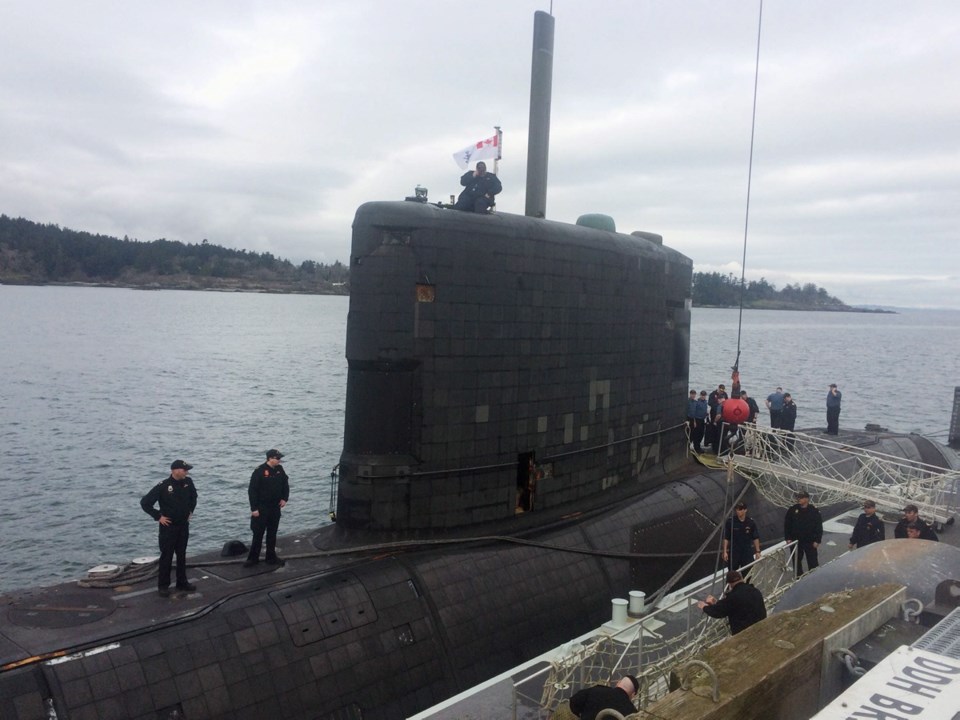The force of the blowback of air from two simulated torpedo launches from Canadian Navy submarine HMCS Victoria sends hats, cameras and notebooks flying, leaving observers gasping in amazement.
“It’s quite spectacular,” said Cmdr. Alex Kooiman aboard the 70-metre-long, 2,400-tonne submarine, following the massive thrust of water fired from its torpedo tubes to simulate test shots.
Canada’s Navy performed the simulation off Victoria to show the readiness of its submarine fleet after years of mechanical, technical and fire-related problems.
HMCS Victoria has six torpedo tubes and can carry up to 18 heavyweight torpedoes for use against surface and sub-surface targets. It fired a live torpedo in a military exercise off Hawaii in 2012, sinking a decommissioned U.S. naval vessel, but the sub has never been in a conflict where its weapons had to be used.
This week, as the submarine cruised at a depth of about 60 metres west of Victoria, Kooiman said the vessel is in full operations mode and ready for any duties.
“We have full weapons capability and all our systems are functioning,” he said in the weapons room. “Anything that the government of Canada asks us, the submarine service, to do, we are able to do on HMCS Victoria.”
Canada’s four long-range, diesel-electric submarines, including HMCS Victoria, were bought from Britain’s Royal Navy in 1998, but the transition to full Canadian Navy operations has not been smooth.
HMCS Windsor, stationed in Halifax, has undergone extensive and costly repairs, and only recently returned to operations. HMCS Chicoutimi is at CFB Esquimalt preparing for operations following a fire in 2004 on its first Canadian voyage that killed one crew member and injured two others. HMCS Corner Brook hit the ocean floor during training exercises off Victoria in June 2011. It is expected to be out of service for repairs until at least 2017.
Capt. Jamie Clarke, commanding officer of Canada’s submarine fleet, said on board Victoria that the West Coast submarine is highly capable, while HMCS Windsor and HMCS Chicoutimi are on their way to getting there.
“Windsor is at sea today on the East Coast,” he said. “Chicoutimi will be back in the next few weeks.”
Clarke said the submarine fleet offers Canada a powerful defence weapon.
“One submarine stored up, fuelled up, can go to sea for 40-plus days and be on station and tell folks and communicate back to folks what’s going on in that neck of the woods,” he said. “Incredibly important, and they can do all of that without anybody knowing they are there.”
The long-range capabilities of the submarines means they can be deployed around the world, Clarke said. “We’ve gone north of 60 in the Arctic. We’ve gone as far south as the Panama Canal, as far east as Europe, Norway, the United Kingdom, as far west as Hawaii,” he said. “So, we’ve covered a significant patch of the globe.”
Clarke said the stealth, surveillance and weapons might of submarines can deter other countries from taking military action.
“To have that ability to influence foreign governments is huge,” Clark said.
New federal Defence Minister Jason Kenney was given a tour of HMCS Chicoutimi on Friday after meeting with navy leaders at CFB Esquimalt.
Kenney’s tour of the submarine was followed by a tour of HMCS Calgary, a recently upgraded frigate — part of the Halifax-class modernization program — and a look at the Fleet Diving Unit (Pacific).
“It was truly remarkable to see first-hand the hard work and progress made by the RCN in this period of modernization and fleet renewal,” Kenney said.
— with a file from Cindy E. Harnett, Times Colonist



